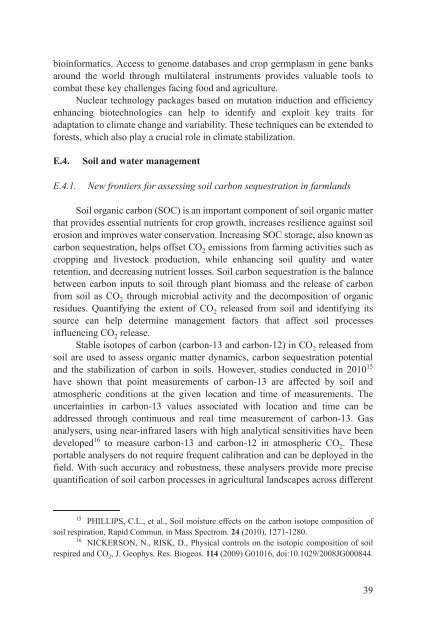Nuclear Technology Review 2011 - IAEA
Nuclear Technology Review 2011 - IAEA
Nuclear Technology Review 2011 - IAEA
You also want an ePaper? Increase the reach of your titles
YUMPU automatically turns print PDFs into web optimized ePapers that Google loves.
ioinformatics. Access to genome databases and crop germplasm in gene banks<br />
around the world through multilateral instruments provides valuable tools to<br />
combat these key challenges facing food and agriculture.<br />
<strong>Nuclear</strong> technology packages based on mutation induction and efficiency<br />
enhancing biotechnologies can help to identify and exploit key traits for<br />
adaptation to climate change and variability. These techniques can be extended to<br />
forests, which also play a crucial role in climate stabilization.<br />
E.4. Soil and water management<br />
E.4.1. New frontiers for assessing soil carbon sequestration in farmlands<br />
Soil organic carbon (SOC) is an important component of soil organic matter<br />
that provides essential nutrients for crop growth, increases resilience against soil<br />
erosion and improves water conservation. Increasing SOC storage, also known as<br />
carbon sequestration, helps offset CO 2 emissions from farming activities such as<br />
cropping and livestock production, while enhancing soil quality and water<br />
retention, and decreasing nutrient losses. Soil carbon sequestration is the balance<br />
between carbon inputs to soil through plant biomass and the release of carbon<br />
from soil as CO 2 through microbial activity and the decomposition of organic<br />
residues. Quantifying the extent of CO 2 released from soil and identifying its<br />
source can help determine management factors that affect soil processes<br />
influencing CO 2 release.<br />
Stable isotopes of carbon (carbon-13 and carbon-12) in CO 2 released from<br />
soil are used to assess organic matter dynamics, carbon sequestration potential<br />
and the stabilization of carbon in soils. However, studies conducted in 2010 15<br />
have shown that point measurements of carbon-13 are affected by soil and<br />
atmospheric conditions at the given location and time of measurements. The<br />
uncertainties in carbon-13 values associated with location and time can be<br />
addressed through continuous and real time measurement of carbon-13. Gas<br />
analysers, using near-infrared lasers with high analytical sensitivities have been<br />
developed 16 to measure carbon-13 and carbon-12 in atmospheric CO 2 . These<br />
portable analysers do not require frequent calibration and can be deployed in the<br />
field. With such accuracy and robustness, these analysers provide more precise<br />
quantification of soil carbon processes in agricultural landscapes across different<br />
15 PHILLIPS, C.L., et al., Soil moisture effects on the carbon isotope composition of<br />
soil respiration, Rapid Commun. in Mass Spectrom. 24 (2010), 1271-1280.<br />
16 NICKERSON, N., RISK, D., Physical controls on the isotopic composition of soil<br />
respired and CO 2, J. Geophys. Res. Biogeos. 114 (2009) G01016, doi:10.1029/2008JG000844.<br />
39

















